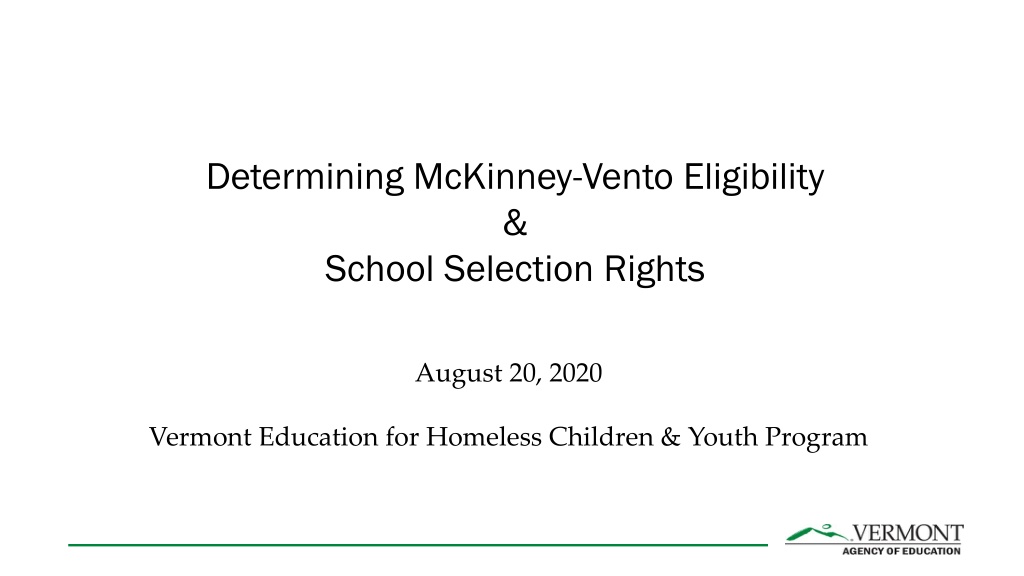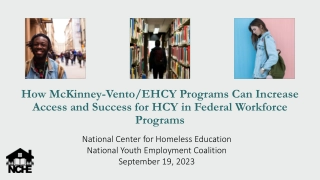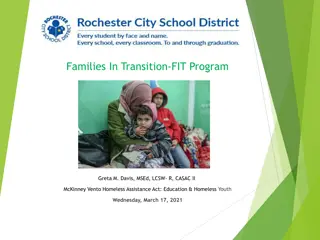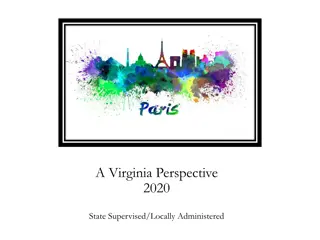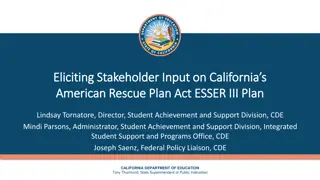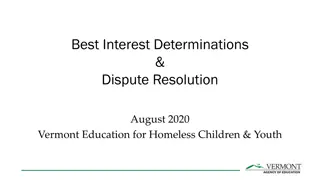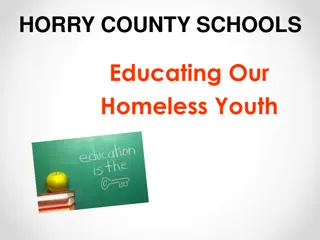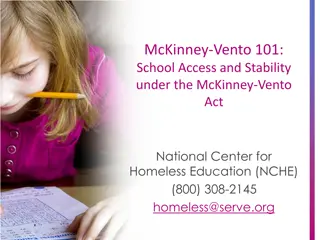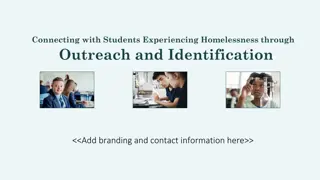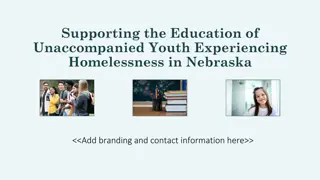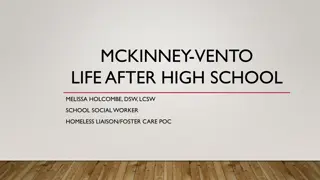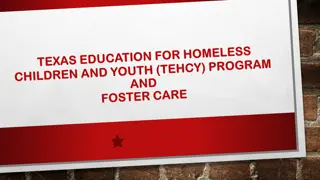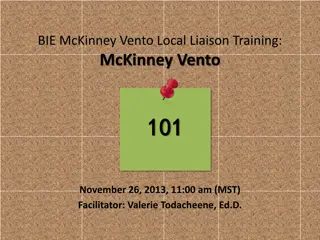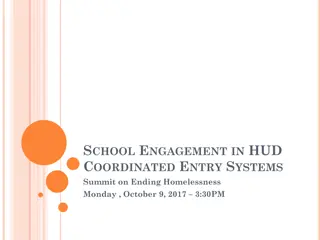Understanding McKinney-Vento Eligibility & School Selection Rights
Explore the McKinney-Vento Act, which addresses the education of homeless children and youth. Learn about eligibility, homeless liaison roles, school selection rights, stability, transportation, and more. Discover common causes of homelessness and the educational support provided under ESSA.
Download Presentation

Please find below an Image/Link to download the presentation.
The content on the website is provided AS IS for your information and personal use only. It may not be sold, licensed, or shared on other websites without obtaining consent from the author. Download presentation by click this link. If you encounter any issues during the download, it is possible that the publisher has removed the file from their server.
E N D
Presentation Transcript
Determining McKinney-Vento Eligibility & School Selection Rights August 20, 2020 Vermont Education for Homeless Children & Youth Program
For todays presentation Please mute your microphone Please turn off your web cam Feel free to ask questions in the chat box This session will be recorded and posted to the website: https://education.vermont.gov/student-support/federal-programs/homeless-education
Final Session August 21, 10-11am: Best Interest Determinations & Dispute Resolution
Todays topics Education & Homelessness The McKinney-Vento Definition of Homelessness Understanding the definition and criteria Role of the Homeless Liaison Strategies for making eligibility determinations School Selection Rights School stability School of origin & school of local attendance area definitions Duration of rights Transportation
ESSA & The McKinney-Vento Act McKinney-Vento Homeless Assistance Act: primary Federal legislative response to homelessness Subtitle VII-B: education of children and youth experiencing homelessness ESSA: reauthorized the Elementary and Secondary Education Act (ESEA) and the education subtitle of the McKinney-Vento Act (Title IX)
ESSA & The McKinney-Vento Act The McKinney-Vento Act Establishes the definition of homeless used by schools Establishes rights given to eligible students Ensures that children and youth experiencing homelessness have equal and immediate access to public education Provides educational support to promote school success
Common Causes of Homelessness Natural disaster Lack of affordable housing Rising prices (housing, food, gas, etc.) Job loss/lack of job opportunities Serious illness/healthcare expenses Mental illness Domestic violence Family dysfunction
How does homelessness affect education? Students experiencing homelessness are more likely to: Be chronically absent Get lower grades Score poorly on assessment tests Have special education needs Drop out of school
Barriers to Education Students experiencing homelessness may: Move around and change schools a lot Be hungry, tired, and stressed Not have school supplies or a quiet place to study Not have access to reliable transportation Be unable to meet school enrollment requirements Not have a parent or guardian to help them
Understanding the McKinney-Vento Definition of Homeless
McKinney-Vento Definition of Homeless Children or youth who lack a fixed, regular, and adequate nighttime residence, including children and youth: Sharing the housing of other persons due to loss of housing, economic hardship, or a similar reason Living in motels, hotels, trailer parks, or camping grounds due to the lack of alternative adequate accommodations Living in emergency or transitional shelters, or are abandoned in hospitals Living in a public or private place, not designed for or ordinarily used as regular sleeping accommodation for human beings Living in cars, parks, public spaces, abandoned buildings, substandard housing, bus or train stations, or similar settings Migratory children living in the above circumstances
Vermont Data Percentage of homeless children/youth enrolled in public schools by type of primary nighttime residence: SY 2016-2017 Total number of students identified: 1,097 7.7% 20.0% 55.1% 17.2% Unsheltered Hotels/Motels Shelters, transitional housing Doubled up
Understanding the Definition Children or youth who lack a fixed, regular, and adequate nighttime residence Fixed Stationary, permanent, not subject to change Regular Used on a predictable, routine, consistent basis Consider the relative permanence Adequate Lawfully and reasonably sufficient Sufficient for meeting the physical and psychological needs typically met in home environments
Substandard housing Living in cars, parks, public spaces, abandoned buildings, substandard housing, bus or train stations, or similar settings Each city, county, or state may have its own housing codes that further define what may be deemed substandard housing Considerations (per USED Guidance): Does the housing lack one of the fundamental utilities such as water, electricity, or heat? Is the housing infested with vermin or mold? Does the housing lack a basic functional part such as a working kitchen or a working toilet? Does the housing present unreasonable dangers to adults, children, or persons with disabilities?
Understanding Doubled Up A shelter stay is not always an option: Shelters don t exist in every community Shelters may be full Shelter policies may create barriers for families Shelters may have stay limits Doubled-up arrangements often serve as temporary shelter, but may not last or may place the family or youth in danger
Sharing the housing of other persons Implies that the child or youth is staying in someone else s residence Clarifying questions Does the family or youth have any legal right to be in the home? Can the family or youth be asked to leave at any time with no legal recourse?
due to loss of housing, Implies that the student has no personal housing available Clarifying questions Did the family or youth lose previous housing due to: An eviction or foreclosure? Destruction of or damage to the previous home? Unhealthy or unsafe conditions? Domestic violence? Abuse or neglect? The absence of a parent or guardian due to abandonment, parental incarceration, or a similar reason?
economic hardship, or similar reason Implies that limited financial resources have forced the family or youth to leave the personal residence Clarifying question Did economic hardship due to an accident or illness, loss of employment, loss of public benefits, or a similar reason force the family or youth to share the housing of others temporarily?
Considerations for Doubled Up Determinations How did the shared housing come about? What is the intention of the residents? What are the family/youth s housing options if not sharing housing? Make determinations on a case-by-case basis
Unaccompanied Homeless Youth (UHY) An unaccompanied homeless youth is a young person who is both homeless (experiencing homelessness according to the McKinney-Vento definition) and unaccompanied (not in the physical custody of a parent or guardian) A guardianship or custody issue without the presence of homelessness does not convey McKinney-Vento eligibility For any young person, including an unaccompanied youth, to be McKinney- Vento eligible, his or her living arrangement must meet the Act s definition of homeless
Unaccompanied Homeless Youth A student may be considered an unaccompanied homeless youth regardless of whether the student was forced from the home or ran away Sometimes what has caused the separation between the student and his/her parents may not be disclosed readily due to its sensitive or private nature
Example The Peterson family is enrolling their three children in your LEA. The enrollment staff have referred the family to you, the homeless liaison, because they are concerned the family may be experiencing homelessness. After following up, you learn that the family has been living out of a camper after being evicted from their apartment. Living in a camper not fixed Lost their home
Example Phillip, his wife, and their 2 children have just moved to Vermont from out of state. They are enrolling their children at your school and mention that they are currently living with Phillip s sister. After following up with the family, you discover that Phillip received a promotion and as a result had to relocate to a different office. They are living with his sister while they look for a new house to buy. Sharing housing Did not lose their housing Does not sound like they are experiencing economic hardship
Example Caleb is a high school student whose mom struggles with substance abuse issues. There are often strangers in his home and mom participates in activities that make Caleb feel unsafe. He decides he would be safer living outside of the home and moves in with a friend. Caleb has been sleeping in his friend s basement for several weeks. Not in the physical custody of a parent or guardian Sharing the housing of another person Loss of housing
Example Sophie just got a new job with a much longer commute. She s hoping to save some money on gas, so she and her son are going move in with a friend at the same job so they can carpool, while Sophie looks for an apartment that s closer to the new job location. Sharing housing with another person Has not lost housing Mutual decision made for mutual benefit
Example Alicia is entering 10th grade and is referred to you as an unaccompanied youth because the enrollment staff found that she is no longer living with her parents. After some additional follow up, you find Alicia s parents travel often for work. They ve decided that it would be best for Alicia to stay with her grandparents until she finishes school because they are often away from home for long periods of time. Not in the physical custody of parents Has not lost housing Parents have made arrangements for her to stay with another caregiver
Example The Dale family has just lost their housing. They are staying with a family friend while they look for permanent housing. The family friend has agreed to let the Dales two elementary school children stay with them; however, the friend does not feel comfortable with their teenage son, Sam, staying in the house as well. So their son is going to stay at a friend s house until the family can be reunited in permanent housing. Not in the physical custody of a parent of guardian Sharing the housing of another person Loss of housing
Role of the Liaison The local liaison has the authority and responsibility to ensure that eligible students are identified Collaborative effort with school personnel Outreach and coordination activities with other entities and agencies Eligibility determinations should be made on a case-by-case basis, considering the circumstances of each student Pay close attention to the legislative wording, as it may provide needed clarity
Strategies for Confirming Eligibility Use a housing questionnaire during enrollment Establish a procedure on the following: Steps to take when a student might be eligible Steps to take when eligibility information needs to be confirmed Personnel who will be involved when confirming eligibility Recommended and prohibited practices Collaboration & Training Prior schools Neighboring liaisons Community agency partners (as appropriate and in accordance with privacy laws) Train appropriate staff (enrollment, school admin, etc.)
Strategies to Avoid Insisting that families provide documentation (eviction notices, utility bills, etc.) Conducting surveillance of families The use of police officers to conduct home visits Seeking information through outside agencies
FERPA Information about a homeless students living arrangement is considered part of the students education record As such, this information is covered by the privacy protections included in FERPA
School Stability Highly mobile students have lower test scores and worse overall academic performance than peers who do not change schools Also affects non-mobile students: Study found that average test scores for non-mobile students were significantly lower in high schools with high student mobility rates Students who switch schools suffer: Psychologically Socially Academically More likely to repeat grades, will have lower math/reading scores
School Selection Rights Children and youth experiencing homelessness have the right to attend: The school of origin: The school that a child or youth attended when permanently housed, or The school in which the child or youth was last enrolled The local attendance area school: Any public school that non-homeless students who live in the attendance area in which the child or youth is actually living are eligible to attend
School of Origin A family became homeless last school year (town 1). At the end of the school year, they became permanently housed in a different LEA (town 2) and the child was enrolled in school there. That situation became abusive, the family became homeless again, and they returned to the town where they were homeless last school year (town 1). The student was re-enrolled as a McKinney-Vento student in the school serving town 1. The family was quickly kicked out of that living situation and moved to a third town (town 3). Where does this child have the right to attend? Town 1 school of origin: school in which the child was last enrolled Town 2 school of origin: school that the child attended when last permanently housed Town 3 school of local attendance area: where the family is actually living
School Selection Rights & Best Interest The law assumes that keeping a student in the school of origin is in the best interest of the student The LEA must, to the extent feasible, keep a student experiencing homelessness in the school of origin, unless it is against the wishes of the parent/guardian or unaccompanied youth
Duration of Rights Homeless children and youth have the right to attend the school of origin for the duration of homelessness In any case in which a family becomes homeless between academic years or during an academic year For the remainder of the academic year, if the child or youth becomes permanently housed during an academic year
School of Origin Preschool The term school of origin means the school that a child or youth attended when permanently housed or the school in which the child or youth was last enrolled, including a preschool. (42 U.S.C. 11432(g)(3)(I)(i)) If an LEA offers a public education to preschool children, including LEA- administered Head Start programs, an LEA must meet the McKinney- Vento Act requirements for preschool children experiencing homelessness This includes ensuring that a homeless child remains in his or her public preschool of origin, unless a determination is made that it is not in the child s best interest
School of Origin Receiving Schools When the child or youth completes the final grade level served by the school of origin, the term school of origin shall include the designated receiving school at the next grade level for all feeder schools. Example: Student completed grade 6 (final grade level) in School A. Students at School A are designated to attend School B beginning in the next grade level, grade 7. The school of origin for this student would therefore include School A and the designated receiving school at the next grade level, School B.
School of Origin Transportation Scenario 1: Living and attending in same LEA If the child or youth continues to live in the area served by the LEA in which the school of origin is located, the child's or youth's transportation shall be provided or arranged by the LEA in which the school of origin is located. Scenario 2: Living in one LEA, attending in another If the child or youth, though continuing to attend the school of origin, begins living in an area served by another LEA, the LEA of origin and the LEA in which the child or youth is living shall agree upon a method to apportion the responsibility and costs for providing the transportation, or, if unable to agree, shall split the responsibility and costs equally
School of Origin Transportation Must LEAs continue to provide transportation to and from the school of origin for formerly homeless students who have become permanently housed? Yes. LEAs must continue to provide transportation to and from the school of origin to formerly homeless students who have become permanently housed for the remainder of the academic year during which the child or youth becomes permanently housed.
School of Origin Transportation Does the McKinney-Vento Act require an LEA to provide transportation services to homeless children attending preschool? The McKinney-Vento Act requires LEAs to provide transportation services to the school of origin, which includes public preschools. Transportation to the school of origin must be provided even if a homeless preschooler who is enrolled in a public preschool in one LEA moves to another LEA that does not provide widely available or universal preschool.
Meeting Students Needs What can schools do to help students who are experiencing homelessness? Stabilize their basic needs: physical, emotional, social What do our students need? What can the school and/or programs do to help meet these needs? How can we help students feel welcome, wanted, and safe in our schools?
Example Lily lives with her mother and mother s boyfriend in a camper. The park where they are staying is closing for the winter (in district A), so they must move. They are relocating their camper to a different campground for the winter, which is in a different LEA (district B). Where can Lily go to school? Lily has the right to remain in the school of origin (in District A), if it is in her best interest, or enroll at the local attendance area school (District B) If it is determined that the school of origin is in her best interest, that district must provide transportation to and from the school of origin Lily will be crossing LEA lines, so the two districts must agree on how to apportion the cost If they cannot agree, the LEAs must split the costs evenly
Example Thomas just completed his 8th grade year, which is the final grade in his school. About a month ago, his family lost their home in a fire and they have been living with his aunt, who lives in a different LEA. He was determined eligible for McKinney-Vento and has remained in his school of origin. Thomas and his parents would like him to move into the high school with his peers. Where is Thomas eligible to attend? The school of origin definition includes receiving schools, so his new school of origin would be the high school that receives students from his current school of origin He could also enroll at the local attendance area school
Example Jessica s husband was recently diagnosed with a debilitating illness and is no longer able to work. As a result, they could no longer afford their rent and were evicted from their home. Their daughter is in third grade. After they were evicted, they moved into a motel in a different LEA until they can find permanent housing. Their daughter was identified as eligible for McKinney-Vento and she has remained in her school of origin with the LEA providing transportation. A week later, Jessica let the school know that they have found an apartment in the LEA where they are currently staying and are now permanently housed. Can Jessica s daughter continue to attend her school of origin? Even though the family now has permanent housing, Jessica s daughter can remain there through the end of the school year duration of rights The LEA must continue to provide transportation to and from the school of origin
